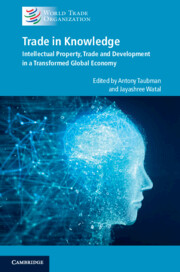Book contents
- Frontmatter
- Contents
- Figures
- Tables
- Contributors
- Preface
- 1 Thematic Overview: Charting the Evolution of Knowledge Flows
- Part I Conceptual Framework
- Part II Measuring Trade in Knowledge
- Part III Impact of Knowledge Flows on Trade and Development
- Part IV Policy, Regulatory and Legislative Frameworks
- Part V Looking Forward
- Index
16 - How do Patents Shape Global Value Chains?
International and Domestic Patenting and Value-Added Trade
from Part III - Impact of Knowledge Flows on Trade and Development
Published online by Cambridge University Press: 17 February 2022
- Frontmatter
- Contents
- Figures
- Tables
- Contributors
- Preface
- 1 Thematic Overview: Charting the Evolution of Knowledge Flows
- Part I Conceptual Framework
- Part II Measuring Trade in Knowledge
- Part III Impact of Knowledge Flows on Trade and Development
- Part IV Policy, Regulatory and Legislative Frameworks
- Part V Looking Forward
- Index
Summary
Intellectual property plays an important role in the global economy through its impact on technology diffusion, knowledge transfer and competition. As production has become fragmented into coordinated processes that span the globe, the role of patents has evolved. Patents can transmit technical knowledge and facilitate upstream and downstream licensing arrangements, thereby increasing the flow of intermediate and final goods and catalyzing knowledge spillovers across sectors and regions. We exploit an algorithmic concordance that links patents to industry and product classifications to estimate how patents affect the organization and structure of Global Value Chains (GVCs). Using the World-Input Output Database as the basis for various GVC measures, we find that increased international patenting inflows are associated with greater value-added production, but that this positive effect is driven entirely by industries in high-income countries. We also find some evidence of heterogeneity in these effects by region and sector-specific R&D intensity. We conclude with discussion of important limitations of this exploratory analysis and implications for future research.
- Type
- Chapter
- Information
- Trade in KnowledgeIntellectual Property, Trade and Development in a Transformed Global Economy, pp. 471 - 497Publisher: Cambridge University PressPrint publication year: 2022



